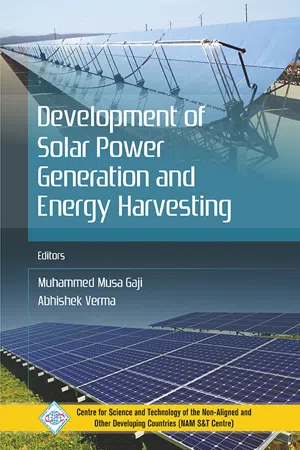
- English
- PDF
- Available on iOS & Android
Development of Solar Power Generation and Energy Harvesting
About this book
The global demand for energy is currently growing beyond the limits of installable generation capacity. To efficiently meet the future energy demands, energy security and reliability needs to be improved and alternative energy sources required to be more aggressively investigated. An effective energy solution should be able to address long-term issues by utilising alternative and renewable energy sources. Of the many available renewable sources of energy, solar energy are clearly a promising option as it is abundantly available at most places and is also the cleanest energy resource on our planet. Solar power, especially as it reaches more competitive levels with other energy sources in terms of cost, may serve to sustain the lives of millions of underprivileged people in developing countries. The recent trends are to decrease the cost of the energy generation either by introducing the low cost processing techniques or by enhancing the efficiency of the solar cells. After the 1st and 2nd generation of the bulk silicon based - and thin-film Si/CdTe/CIGS based solar cells, the 3rd generation technologies are underway. The new technologies include photo-electrochemical cells, polymer solar, quantum dot, tandem / multi-junction, up-conversion and down-conversion, surface plasmonic and nano-crystal solar cells and other novel innovations and inventions. To deliberate on the current trends in solar power generation, its harnessing, storage, solar energy conversion, processing technologies, modeling and simulation plus engineering of the small solar energy generation plants and related issues, the Centre for Science & Technology of the Non-Aligned and Other Developing Countries (NAM S&T Centre) jointly with the Amity University, UP, India - Dubai Campus organised an International Workshop on 'Trends in Solar Power Generation and Energy Harvesting' in Dubai during 27-29 March 2017 which brought together the senior experts and professionals from 23 countries to a common platform.The present book edited by editors Engr. Muhammed Musa Gaji and Dr. Abhishek Verma is a follow up of the above workshop and comprises 20 scientific papers by the authors from 17 countries covering several issues related to the status and trends of solar power generation, designing of solar cells, risk assessment of solar power plants and many other topics. The book will be an asset to the researchers, policy makers in government departments and ministries and non government organisations engaged in renewable energy related issues in the developing countries.
Frequently asked questions
- Essential is ideal for learners and professionals who enjoy exploring a wide range of subjects. Access the Essential Library with 800,000+ trusted titles and best-sellers across business, personal growth, and the humanities. Includes unlimited reading time and Standard Read Aloud voice.
- Complete: Perfect for advanced learners and researchers needing full, unrestricted access. Unlock 1.4M+ books across hundreds of subjects, including academic and specialized titles. The Complete Plan also includes advanced features like Premium Read Aloud and Research Assistant.
Please note we cannot support devices running on iOS 13 and Android 7 or earlier. Learn more about using the app.
Information
Table of contents
- Cover
- Half Title
- About the Centre
- Title
- Copyright
- Foreword
- Preface
- Introduction
- Contents
- 1. Solar photovoltaic energy in Cambodia “An Opportunity with Obstacles”
- 2. Effect of partial Shading on the PV Module output
- 3. Current Status of Solar power in India
- 4. Optimization of Hydrogented Amorphous/Nanocrystalline Si1-XGex Thin Films by Pulsed Plasma CVD
- 5. An overview of risk Management in Solar pv projects
- 6. Evaluation on Operation of Independent Power Producer (IPP) 5 MWp Photovoltaic Power Generator in Kupang, East Nusa Tengga a, Indonesia
- 7. A Review on Solar Thermal Technologies for Low and Medium temperature Industrial Process Heat
- 8. Solar PhotoVoltaic Adoption in Mauritius: Opportunities and Challenges
- 9. On Morocco’s Renewable Energy After COP 22
- 10. Evaluating the Performance of the PV-Modules Available in Palestinian Market
- 11. Updates on the Transforming Commitments into Action-DOST MIMAROPA Experiences
- 12. An Overview of Solar Energy Landscape, Solar Radiation and Solar Cells Studies in Limpopo Province of South Africa
- 13. Fabrication of CdS/CdTe Thin Film Solar Cells via the Technique of Electrodeposition
- 14. Advanced Materials in the Structure of Solar Cells
- 15. The Solar Resource
- 16. Simulation and Prediction of the Power Output and the Photocurrent for Photovoltaic Systems
- 17. Quantitative Analysis of Commercial Solar Cells and Photovoltaic Modules with Electroluminescence
- 18. Trends in Solar Power Generation and Energy Harvesting in Zimbabwe
- 19. Estimation of the Performance of a Solar Photovoltaic Power Plant Using Based program
- 20. The Possibility of Sustainable Renewable Energy for Nigeria as the Way Forward
- Dubai Resolution on Trends in Solar Power Generation and Energy Harvesting in Developing Countries